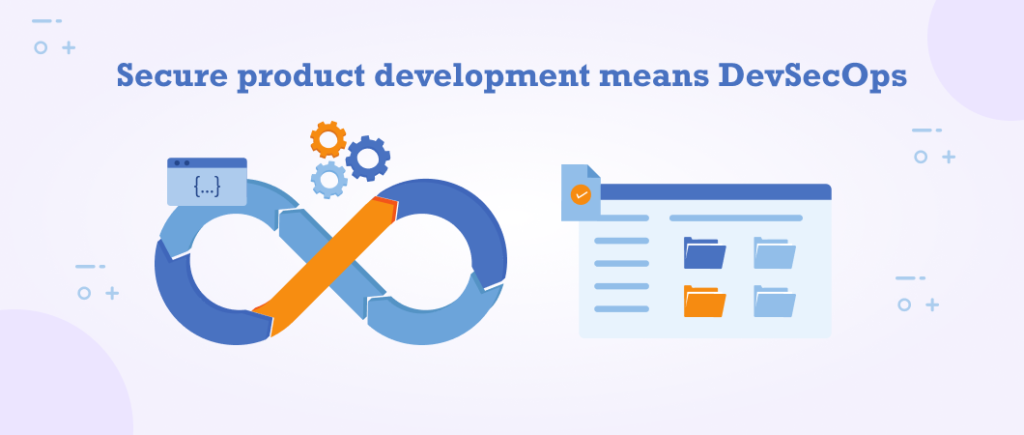Last updated on May 6th, 2024
By 2030, there will be 15 connected devices for every individual on the planet.
- The number of devices and applications continue to rise
- Workforces are becoming remote
- Networks are becoming more diffused
These changes have created a significant challenge for developers as well as IT professionals working on the deployment and maintenance of applications. Here, finding the right balance of reliability of applications and speed of release may become the key to success as organizations strive for agility.
Security Challenge in DevOps
DevOps evolved to help businesses strike this balance by providing great customer outcomes in the shortest possible time frame.
But has DevOps free of risk? Is enough attention being paid to the inherent security challenges?
- Conflict in objectives
The primary goal of developers is to release the software as quickly as possible through frequent fixes, updates, and new features. But traditionally, the security team is more focused on testing rather than speed and efficiency. The conflict between application security testers and the release pressures can be a problem. And the best way to address this conflict is to address security concerns at an early development stage to facilitate greater collaboration rather than conflicts.
- Slow security testing
There is a dire need to adopt a shift-left approach to security to ensure proper integration between security and DevOps. In conventional development methods like the waterfall model, the development cycles take a longer time to complete due to which the security teams can conduct extensive security testing. But in the modern DevOps environment, there is no room for compromise when it comes to laborious security testing. Increasing security test automation has become crucial.
- Complications of cloud security
While the cloud provides a scalable and low-cost computing environment for development, testing, and running applications, it comes with its own set of security vulnerabilities. Learn more about performance testing in the age of the cloud here. Even a minor misconfiguration or vulnerability can lead to compromises in the security of the application, it is necessary to use the new-age tools to monitor the cloud usage for vulnerabilities.
- Supply chain vulnerabilities in the software
The use of open frameworks and open-source libraries in the application has grown with the increased pressure of speed in DevOps. While open-source projects do provide ready-to-use code snippets to enhance the functionality of the application, the increased risk of using open-source vulnerabilities is a serious concern. According to a research report, over 41% of apps are at a high risk of open-source vulnerabilities. The best solution is to educate the DevOps team on the security of the software supply chain.
The Rise of DevSecOps
There are various challenges in the conventional DevOps environment, making enterprises shift to DevSecOps. DevSecOps is the integration of the DevOps model, organizational culture, fast-feedback software delivery, and information security practices. While DevOps add information security to specific stages of the development cycle, DevSecOps integrate the engineering and security objectives throughout the software development lifecycle with a “shift-left” approach.
DevOps Vs. DevSecOps
| DevOps | DevSecOps | |
| Purpose | Involved in the everyday aspects of the engineering process and aims to achieve higher speed. | The main aim is to provide high-end security while applying a higher speed of accessibility and scalability. |
| Team skill-set | Scripting knowledge of multiple DevOps tools and technologies along with fundamentals of Linux. | The team should be skilled to detect security vulnerabilities with the knowledge of automated testing tools. The team should also have extensive knowledge of cloud security. |
| Goal | The primary goal is to bridge the communication gap across teams by focusing on continuous integration, automation, and collaboration to reduce risks and deliver software quality faster. | The main goal is to maintain a high level of speed, control, and security. |
| Emphasis | Software development | Create a compliant and secure code to minimize data loss and downtime. |
| Security initiation | Security begins after the pipeline of development. | Security begins during the process of software development. |
| Challenges | Change the well-defined processes into efficient processes and switch to microservices architecture. | Overload of developers and lack of AppSec tool integration. |
| Benefits | Simplifies the development process and supports end-to-end responsibility. | Reduce the risks and liabilities, minimize the resources, and cost. |
How DevSecOps can improve security outcomes?
When security protocols are baked into the development process rather than added on as a “top layer”, it allows security professionals to securely harness the power of agile development methodologies.
The implementation of DevSecOps can lead to enhanced outcomes of security by improving the operational efficiency across IT infrastructure and achieving better ROI in existing security infrastructure. Another benefit of adopting the DevSecOps environment is that it allows enterprises to leverage cloud services completely. For example, organizations using the Amazon Web Services (AWS) can reap the benefits of the detective as well as preventive security controls within the AWS deployment model.
The Benefits of Adopting DevSecOps
Here are the benefits of adopting the DevSecOps approach
Greater agility and speed
DevSecOps facilitates faster delivery of software by integrating security practices seamlessly into the development pipeline, eliminating bottlenecks and delays.
Increased ability to respond to changes quickly
With DevSecOps, teams can adapt to changes in requirements or market conditions swiftly, ensuring that security measures evolve alongside the software.
Better collaboration across teams
DevSecOps promotes collaboration among development, security, and operations teams, fostering a culture of shared responsibility and effective communication.
Better opportunities for automation
Automation is a cornerstone of DevSecOps, enabling repetitive tasks such as testing, deployment, and security checks to be streamlined, freeing up resources for more strategic initiatives.
Early identification of code vulnerabilities
By integrating security testing throughout the development lifecycle, DevSecOps enables the early detection and remediation of security flaws, minimizing the risk of costly breaches.
Minimize application vulnerabilities
DevSecOps emphasizes continuous monitoring and security controls, reducing the likelihood of introducing vulnerabilities into the application during development or deployment.
Maintain security and compliance throughout the development process
By embedding security measures into every stage of development, DevSecOps ensures that security and compliance requirements are met consistently, mitigating regulatory risks and enhancing trust with stakeholders.
Leverage the revolution of DevSecOps with us
In this complex world where we must deal with millions of applications and security concerns, it is necessary to find a harmony between automation, lean principles, culture, functionality, and best security practices. While DevOps suffers from a lot of security challenges, now is the time to switch to automation and the DevSecOps environment. The methods of DevSecOps have enormous benefits on security as well as the development side that leads to faster software delivery and better stability.
If you are looking for a way ahead to get started with the implementation of the DevSecOps environment or leverage automation, talk to us today.
FAQ
What is DevOps and DevSecOps?
DevOps is a software development methodology that aims to integrate development (Dev) and operations (Ops) teams to improve collaboration, efficiency, and quality throughout the software development lifecycle. DevSecOps extends this approach by integrating security (Sec) practices into the DevOps process, making security an integral part of the development pipeline.
What are the key principles of DevOps and DevSecOps?
The key principles of DevOps include automation, collaboration, continuous integration (CI), continuous delivery (CD), and monitoring. DevSecOps adds security as a fundamental principle, emphasizing the importance of integrating security practices early and throughout the development process.
What are some common security practices in DevSecOps?
Common security practices in DevSecOps include automated security testing (such as static application security testing and dynamic application security testing), infrastructure as code (IaC) security, vulnerability management, secrets management, and identity and access management (IAM) controls.
What are the benefits of adopting DevSecOps practices?
The benefits of adopting DevSecOps practices include improved security posture, faster time-to-market, reduced security vulnerabilities, increased collaboration between development, operations, and security teams, enhanced compliance with regulatory requirements, and overall improved software quality.
How does DevSecOps contribute to compliance and regulatory requirements?
DevSecOps contributes to compliance and regulatory requirements by integrating security controls and practices into the development pipeline, automating compliance checks, providing audit trails and documentation of security activities, and enabling continuous monitoring and remediation of security issues.
What role do automation and orchestration play in DevSecOps?
Automation and orchestration are essential components of DevSecOps, enabling the continuous integration, delivery, testing, and deployment of secure software at scale. Automation helps streamline repetitive tasks, while orchestration coordinates the execution of various security tools and processes within the DevSecOps pipeline.



